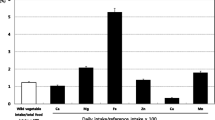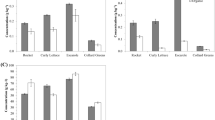Abstract
Vegetables are important contributors to a healthy diet, and their adequate daily intake can help prevent some of the major illnesses. The aim of the study was to examine the content of the major and trace elements in selected organically grown (OG) and conventionally grown (CG) vegetables (cabbage, kohlrabi, Brussels sprout, beetroot, carrot, potato, and onion), taken from city green markets. Multi-elemental analysis was carried out by inductively coupled plasma method with optical emission spectrometry (ICP-OES). Nutritional quality evaluation in comparison to nutritional reference values was done. In studied vegetables, Al, Ca, K, Fe (with the exception of organic kohlrabi), Mg, Na, P, S, and Zn were quantified in all samples, whereas As, Cd, Co, Hg, Se, and V were below the limit of detection for these elements. Macroelements and trace elements were found at higher concentrations in OG and CG vegetables, respectively. Differences in concentrations of studied elements between the same vegetable species produced in two agricultural systems were significant, except for beetroot (p ≤ 0.05). Principal component analysis and hierarchical cluster analysis results showed that the botanical origin had higher influence on sample differentiation than the agronomic practice, which was in accordance with the results obtained by Mann-Whitney U test. Good quality of both OG and CG vegetables in respect of nutritionally beneficial elements was observed.



Similar content being viewed by others
Data Availability
All data generated or analyzed during this study are included in this published article and its supplementary information file
References
Abellán Á, Domínguez-Perles R, Moreno DA, García-Viguera C (2019) Sorting out the value of cruciferous sprouts as sources of bioactive compounds for nutrition and health. Nutrients 11:429. https://doi.org/10.3390/nu11020429
Yahia EM, Maldonado Celis ME, Svendsen M (2018) The contribution of fruit and vegetable consumption to human health. In: Yahia EM (ed) Fruit and vegetable phytochemicals: chemistry and human health, 2nd edn. Wiley, pp 3–52
Hanif R, Iqbal Z, Iqbal M, Hanif S, Rasheed M (2006) Use of vegetables as nutritional food: role in human health. J Agric Biol Sci 1:18–22
Agudo A (2005) Measuring intake of fruits and vegetables. WHO. https://www.who.int/dietphysicalactivity/publications/f&v_intake_measurement.pdf?ua=1. Accessed 10 November 2020
Martins AC, Nunes Krum B, Queirós L, Tinkov AA, Skalny AV, Bowman AB, Aschner M (2020) Manganese in the diet: bioaccessibility, adequate intake, and neurotoxicological effects. J Agric Food Chem 68:12893–12903. https://doi.org/10.1021/acs.jafc.0c00641
Martínez-Ballesta MC, Dominguez-Perles R, Moreno DA, Muries B, Alcaraz-López C, Bastías E, García-Viguera C, Carvajal M (2010) Minerals in plant food: effect of agricultural practices and role in human health. A review. Agron Sustain Dev 30:295–309. https://doi.org/10.1051/agro/2009022
Sanlier N, Guler Saban M (2018) The benefits of Brassica vegetables on human health. J Human Health Res 1(104):1–13
Glantz K (2005) IARC handbooks of cancer prevention Volume 8: Fruit and Vegetables. IARC Press, Lyon, pp 1–19
Slavin JL, Lloyd B (2012) Health benefits of fruits and vegetables. Adv Nutr 3:506–516. https://doi.org/10.3945/an.112.002154
Worthington V (2001) Nutritional quality of organic versus conventional fruits, vegetables, and grains. J Altern Complem Med 7:161–173
Marles RJ (2017) Mineral nutrient composition of vegetables, fruits and grains: the context of reports of apparent historical declines. J Food Compos Anal 56:93–103
Mohammadi S, Pourakbar L, Moghaddam SS, Popović-Djordjević J (2021) The effect of EDTA and citric acid on biochemical processes and changes in phenolic compounds profile of okra (Abelmoschus esculentus L.) under mercury stress. Ecotoxicol Environ Saf 208:111607. https://doi.org/10.1016/j.ecoenv.2020.111607
Gupta N, Kumar Yadav K, Kumar V, Kumar S, Chadd RP, Kumar A (2019) Trace elements in soil-vegetables interface: translocation, bioaccumulation, toxicity and amelioration - a review. Sci Total Environ 651:2927–2942
Hoo Fung LA, Antoine JMR, Grant CN, Lalor GC (2015) Vegetables and fruits. In: de la Guardia M, Garrigues S (eds) Handbook of mineral elements in food. Wiley, UK, pp 489–520
Bourn D, Prescott J (2002) A comparison of the nutritional value, sensory qualities, and food safety of organically and conventionally produced foods. Crit Rev Food Sci 42:1–34. https://doi.org/10.1080/10408690290825439
Vlahović B, Užar D, Škatarić G (2019) Comparative analysis of organic food markets in the Republic of Serbia and the neighboring countries. Contemporary Agriculture 68:34–42. https://doi.org/10.2478/contagri-2019-0007
Leclerc J, Miller ML, Joliet E, Rocquelin G (1991) Vitamin and mineral contents of carrot and celeriac under mineral or organic fertilization. Biol Agric Hort 7:349–361
Hansen H (1981) Comparison of chemical composition and taste of biodynamically and conventionally grown vegetables. Qual Plant — Pl Fds Hum Nutr 30:203–211
Jorhem L, Slanina P (2000) Does organic farming reduce the content of Cd and certain other trace metals in plant foods? A pilot study. J Sci Food Agric 80:43–48
Lombardo S, Pandino G, Mauromicale G (2014) The mineral profile in organically and conventionally grown “early” crop potato tubers. Sci Hort 167:169–173
Golubkina NA, Seredin TM, Antoshkina MS, Kosheleva OV, Teliban GC, Caruso G (2018) Yield, quality, antioxidants and elemental composition of new leek cultivars under greenhouse organic or conventional system. Horticulturae 4:39. https://doi.org/10.3390/horticulturae4040039
Popovic-Dordevic J, Bokan N, Dramicanin A, Brceski I, Kostic A (2017) Content and weekly intake of essential and toxic elements in Serbian vegetables. J Environ Prot Ecol 18:889–898
Popović-Djordjević J, Marjanović ŽS, Gršić N, Adžić T, Popović B, Bogosavljević J, Brčeski I (2019) Essential elements as a distinguishing factor between mycorrhizal potentials of two cohabiting truffle species in riparian forest habitat in Serbia. Chem Biodivers 16:e1800693. https://doi.org/10.1002/cbdv.201800693
U.S. Environmental Protection Agency Method 2007. (1994) Determination of metals and trace elements in water and wastes by inductively couled plasma-atomic emission spectrometry, revision 4. 4. https://www.epa.gov/esam/method-2007-determination-metals-and-trace-elements-water-and-wastes-inductively-coupled-plasma
Pravilnik o deklarisanju, označavanju i reklamiranju hrane (“Regulation on labeling and advertising of food”) (“Official Gazette RS”. No. 19/2017 and 16/2018) (in Serbian); http://demo.paragraf.rs/WebParagrafDemo/?did=424789. Accessed 20 June 2020
Quintaes KD, Diez-Garcia RW (2015) The importance of minerals in the human diet. In: de la Guardia M, Garrigues S (eds) Handbook of mineral elements in food. Wiley, UK, pp 1–21
Gopalan C, Ramasastry BV, Balasubramanian SC (1991) Nutritive value of Indian foods. National Institute of Nutrition, Hyderabad, p 47
Holland B, Unwin JD, Buss DH (1991) Vegetables, herbs and spices: fifth supplement to McCance and Widdowson’s, London.
Petek M, Toth N, Pecina M, Karažija T, Lazarević B, Palčić I (2019) et al. Beetroot mineral composition affected by mineral and organic fertilization. PLoS ONE 14:e0221767. https://doi.org/10.1371/journal.pone.0221767
Dini I, Tenore GC, Dini A (2008) Chemical composition, nutritional value and antioxidant properties of Allium caepa L. Var. tropeana (red onion) seeds. Food Chem 107:613–621
White PJ, Bradshaw JE, Dale MFB, Ramsay G (2009) Relationships between yield and mineral concentrations in potato tubers. Hortscience 44:6–11
Kale RG, Sawate AR, Kshirsaga RB, Patil BM, Mane RP (2018) Studies on evaluation of physical and chemical composition of beetroot (Beta vulgaris L.). Int J. Chem Stud 6:2977–2979
Popović-Djordjević J, Paunović D, Milić A, Krstić Đ, Siavash Moghaddam S, Roje V (2021) Multi-elemental analysis, pattern recognition techniques of wild and cultivated rosehip from Serbia and nutritional aspect. Biol Trace Elem Res 199:1110–1122. https://doi.org/10.1007/s12011-020-02199-4
Hewlings S, Kalman D (2019) Sulfur in human health. EC Nutrition 14(9):785–791
Siderer Y, Maquet A, Anklam E (2005) Need for research to support consumer confidence in the growing organic food market. Trends Food Sci Tech 16:332–343
Hoefkens C, Verbeke W, Aertsens J, Mondelaers K, Van Camp J (2009) The/nutritional and toxicological value of organic vegetables: consumer perception versus scientific evidence. Brit Food J 111:1062–1077. https://doi.org/10.1108/00070700920992916
Dangour AD, Dodhia SK, Hayter A, Allen E, Lock K, Uau R (2009) Nutritional quality of organic foods: a systematic review. Am J Clin Nutr 90:680–685. https://doi.org/10.3945/ajcn.2009.28041
Pfeilsticker K (1992) Quality of organic-grown food — an experimental, multifactorial approach on vegetables for example, In: Proceedings of the 9th IFOAM Conference, Brazil. Germany, IFOAM, pp. 331-337.
Knap M, Nečemer M, Kump P, Potočnik K, Vidrih R (2014) The content of minerals in Slovenian organic and conventional produced fruits, herbs and vegetables. Acta Agric Slov 103:271–279. https://doi.org/10.14720/aas.2014.103.2.11
Caruso G, Villari G, Borrelli C, Russo G (2012) Effects of crop method and harvest seasons on yield and quality of green asparagus under tunnel in southern Italy. Adv Hort Sci 26:51–58
Caruso G, De Pascale S, Cozzolino E, Cuciniello A, Cenvinzo V, Bonini P, Colla G, Rouphael Y (2019) Yield and nutritional quality of Vesuvian Piennolo tomato PDO as affected by farming system and biostimulant application. Agronomy 9:505. https://doi.org/10.3390/agronomy90
Hamzić Gregorčić S, Strojnik L, Potočnik D, Vogel-Mikuš K, Jagodić M, Camin F, Zuliani T, Ogrinc N (2020) Can we discover truffle’s true identity? Molecules 25:2217. https://doi.org/10.3390/molecules25092217
de Lima MD, Barbosa R (2019) Methods of authentication of food grown in organic and conventional systems using chemometrics and data mining algorithms: a review. Food Anal Methods 12:887–901. https://doi.org/10.1007/s12161-018-01413-3
Miljković I, Popović-Djordjević J, Rajković BM, Kostić ŽA, Popović B, Brčeski I (2019) Quantification of selected toxic and potentially toxic elements in vegetables and health risk assessment. In 30th Scientific-Experts Conference of Agriculture and Food Industry, AgriConf. Brka M., Omanović-Mikličanin E., Karić L., Falan V., Toroman A. (eds); AgriConf IFMBE Proceedings 78. pp. 229–236. https://doi.org/10.1007/978-3-030-40049-1_29
Peuke AD (2010) Correlations in concentrations, xylem and phloem flows, and partitioning of elements and ions in intact plants. A summary and statistical re-evaluation of modelling experiments in Ricinus communis. J Exp Bot 61:635–655
Technical guidance on nutrition labeling 2016. https://www.gov.uk/government/publications/technical-guidance-on-nutrition-labelling. Accessed on 16 September 2020
Acknowledgements
Authors are grateful to the Public Utility Company “Belgrade City Markets” for enabling vegetable sampling.
Funding
This work resulted from research within the framework of the contract for the realization and financing of scientific research work in 2020 between the Faculty of Agriculture and Faculty of Chemistry in Belgrade, and the Ministry of Education, Science and Technological development of the Republic of Serbia, registration number contracts: 451-03-9/2021-14/ 200116 and 451-03-9/2021-14/ 200168.
Author information
Authors and Affiliations
Contributions
Conceptualization and methodology, J.P.Dj.; sample preparation and investigation, I.M. and A.K.; instrumental analysis, I.B.; data curation, M.B.R. and S.S.M.; statistical analyzes, Đ.K.; writing—original draft preparation, J.P.Dj. and I.B.; writing—review and editing, J.P.Dj., SSM and G.C.; visualization, J.P.Dj.; supervision, J.P.Dj., G.C. and I.B. All authors have read and approved the final version of the manuscript.
Corresponding author
Ethics declarations
Conflict of Interest
The authors declare no competing interests.
Additional information
Publisher’s Note
Springer Nature remains neutral with regard to jurisdictional claims in published maps and institutional affiliations.
Supplementary Information
Supplementary material for this article is available on the WWW under XXX.
ESM 1
(DOC 1.82 mb)
Rights and permissions
About this article
Cite this article
Popović-Djordjević, J.B., Kostić, A.Ž., Rajković, M.B. et al. Organically vs. Conventionally Grown Vegetables: Multi-elemental Analysis and Nutritional Evaluation. Biol Trace Elem Res 200, 426–436 (2022). https://doi.org/10.1007/s12011-021-02639-9
Received:
Accepted:
Published:
Issue Date:
DOI: https://doi.org/10.1007/s12011-021-02639-9




